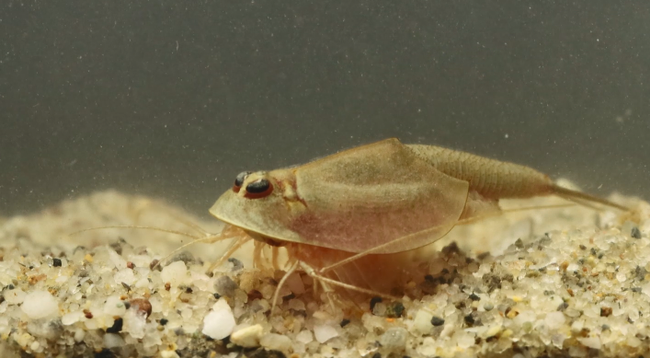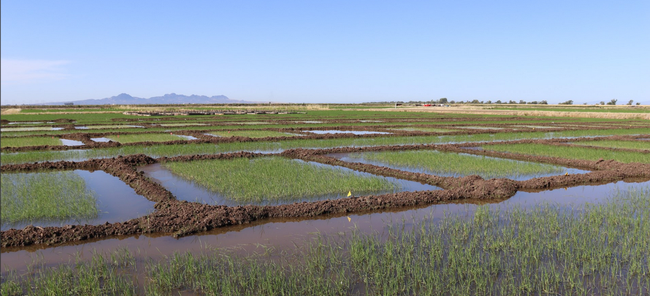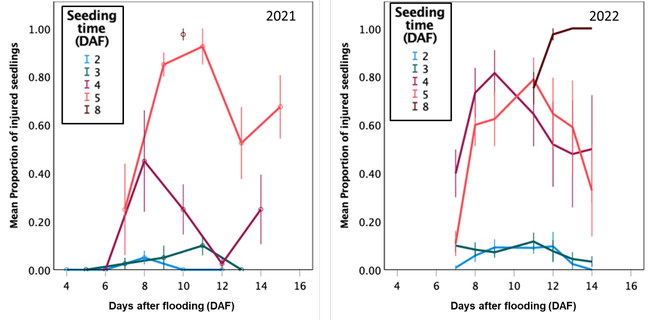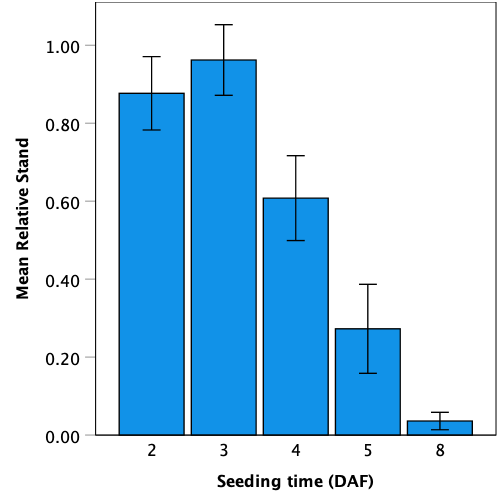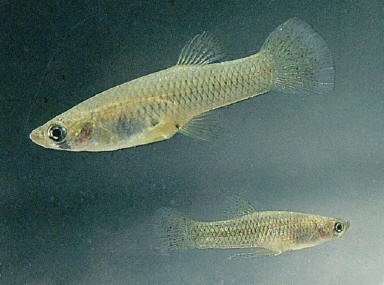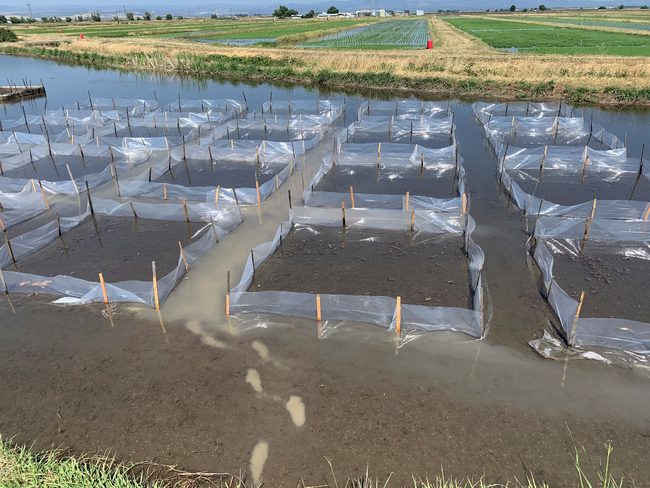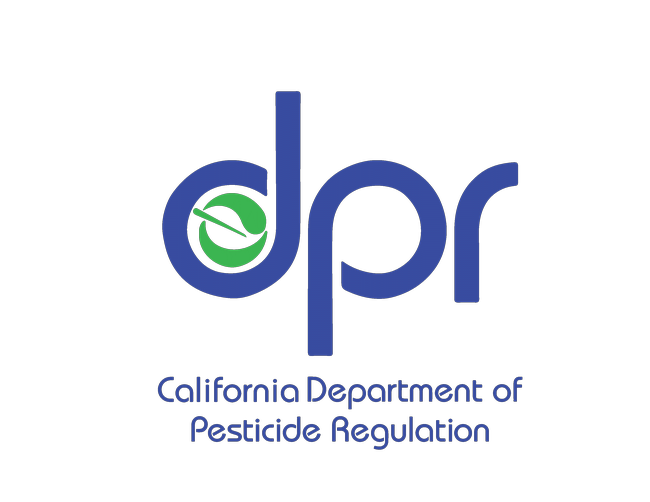With rice pushing fully through the water and with many fields now a vibrant green, tadpole shrimp season has passed in California's rice fields. Fields that had tadpole shrimp eggs lurking in the soil would have had a flush of tadpole shrimp soon after fields were flooded, although insecticide applications or water management (drying the field) may have killed many off. There may still be lingering evidence of stand loss from fields that suffered tadpole shrimp damage. Most shrimp that were in fields will have cycled out at this point, laying their eggs over a few weeks and then dying. Nevertheless, our team is continuing to finish out our field work this year and conduct a number of lab and greenhouse studies aimed at developing an integrated management plan for tadpole shrimp. This project is ongoing, but it is worth covering some of the studies, research questions, and results thus far.
Tadpole shrimp are one of the key arthropod pests of rice in California. They can kill or damage germinating seeds/seedlings and can cause seedlings to uproot and drift away. Management typically entails insecticide applications, especially in conventional production. In organic systems, insecticide options are much more limited, although water management approaches (field dry down) can also help manage tadpole shrimp. While management itself is challenging, scouting and determining the risk of damage based on when a field is planted and environmental conditions can also be challenging. Furthermore, we do not currently have a great idea if tadpole shrimp, which are notably omnivorous, are also suppressing weed populations by feeding on germinating weeds. This could be an unrecognized benefit to having at least some tadpole shrimp in a field. Our project, funded by a CA Department of Pesticide Regulation grant, aims to develop new tools and approaches to tadpole shrimp management and to enhance our understanding of their ecology in rice fields to promote better management.
Damage potential of tadpole shrimp
One component of this project is to better understand the relationship or “arms race” between tadpole shrimp and rice. For both rice and tadpole shrimp, adding water starts the clock on their growth. We already know that quickly flooding fields and prompt planting can help reduce the likelihood of tadpole shrimp damage; this helps the rice grow out of the “damage danger zone” when rice is smaller and can be damaged by shrimp that are large enough to damage the rice. Fine tuning recommendations around these timings would help better predict when damage could occur. A field study at the Rice Experiment Station has already begun to do this. Across two years, we saw that damage was minimal to plantings seeded 2 or 3 days after flooding (seedling damage in Figure 2, 2021 stand count shown in Figure 3). However significant damage started to occur when fields were seeded 4 days after flooding. Waiting until 8 days after flooding was a sure-fire way to get extensive damage.
Figure 1. Field trials to examine the damage potential of tadpole shrimp at different seeding times.
Figure 2. Damage to seedlings in plots that were seeded at various time points after flooding and in two different trials. There were fewer points for the 8 DAF timing, but that was because seeds never even became seedlings.
Figure 3. Stand loss in plots that were seeded at various time points after flooding in the 2021 trial.
We are also investigating how shrimp density, which can vary, interacts with seeding time. Furthermore, we hope to better elucidate how both rice and shrimp respond to different temperatures and how this affects damage risk. During the spring, temperature can be highly variable. At times, it can be cool, while at other times it can be blisteringly hot. We anticipate that better understanding this relationship will be critical as we experience more early season hot spells.
Biological control
Another aspect of the project is to examine if biological control of tadpole shrimp could be a way to manage this pest. While all sorts of predators will eat different stages of tadpole shrimp, from aquatic insects like diving beetles to birds like ibis, these predators are difficult to manipulate. One type of fish, mosquitofish, may be a predator that could be manipulated that might suppress tadpole shrimp. We are in progress with our studies (including a number of field studies, Figure 5), but several key points have become apparent. First, the rate of fish is critical and may contribute to the success of this tactic. Higher stocking rates have reduced shrimp populations at times, but when fewer fish were added, they appear to not eat enough tadpole shrimp to be noticeable. These predators are generalists, so they likely are eating other types of arthropods within the plots. In addition, timing appears very important. Adding fish much after flooding/seeding, perhaps even between 1 and 3 days after seeding, could not give them enough time to eat the shrimp when they are still small. At some point, although we need to determine when, the fish will simply not be able to eat the rapidly growing tadpole shrimp.
Figure 4. Mosquitofish (Gambusia affinis, photo credit: Robert McDowall
Figure 5. Field plots used to examine the biological control potential of mosquitofish for tadpole shrimp management.
Weed management by tadpole shrimp?
In contrast to the rice damage they can cause, tadpole shrimp may actually provide weed management benefits. Our project is also evaluating the capacity of tadpole shrimp to feed on rice weeds. Growers and PCAs may benefit from a reduction on rice weeds establishment by allowing tadpole shrimp to feed on rice weeds when rice is not susceptible to injury. Biological control of rice weeds by tadpole shrimp would replace herbicide use, but it may help avoid weed escapes, which promote the development of herbicide-resistant weeds. Again, these studies are ongoing, but we have already made a few interesting observations, which will be solidified as we conduct and complete studies. Greenhouse studies (Figure 6) have shown that while tadpole shrimp will definitely consume and damage weed seedlings, the species identity of the weeds matters. Containers were treated like a small mesocosm and focused on specific weed species one at a time. There were containers for each weed species with either no shrimp or two different densities of shrimp. Tadpole shrimp readily consumed a number of broadleaved weed species like redstem, but appeared to not damage bulrush (Figure 7). Additional studies are examining the typical complement of weed species all at once. While tadpole shrimp may reduce weed populations in a field, ideally without damaging the rice, it seems like they may not damage all weed species.
Figure 6. Experimental setup for greenhouse study examining if tadpole shrimp will consume seedlings of different weed species.
Figure 7. Effect of tadpole shrimp (none on left container within each photo, with tadpole shrimp in center and right containers at two different densities). The left image shows the effect of tadpole shrimp on bullrush (minimal), while the right shows the effect on redstem (all consumed).
Towards improved IPM for tadpole shrimp
Overall, we hope that increased knowledge about how tadpole shrimp interact with rice and with weeds may help better target management tactics. Insecticides are widely used and often effective, but there may be ways to use them in a more targetted and effective manner. This is especially important given possible insecticide resistance issues for tadpole shrimp. Tadpole shrimp will likely remain a key arthropod pest in rice, so optimizing management plans will help manage these pests sustainably and effectively.
Funding for this project has been provided in full or in part through a Grant awarded by the Department of Pesticide Regulation
Author - County Director, Sutter and Yuba Counties and CE Rice and Wild Rice Advisor
